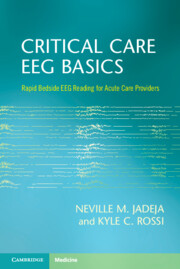Book contents
- Critical Care EEG Basics
- Critical Care EEG Basics
- Copyright page
- Dedication
- Contents
- Foreword
- Preface
- Acknowledgments
- How to Read This Book
- Part I Introduction
- Chapter 1 EEG Basics
- Chapter 2 Indications
- Chapter 3 Real-Time Bedside EEG Reading
- Chapter 4 Recognizing Artifacts and Medication Effects
- Chapter 5 Epileptiform Discharges, Seizures, and Status Epilepticus
- Chapter 6 Rhythmic and Periodic Patterns (RPPs) and the Ictal‐Interictal Continuum (IIC)
- Chapter 7 Post–Cardiac Arrest EEG
- Chapter 8 Quantitative EEG (EEG Trend Analysis)
- Part II Case-Based Approach to Specific Conditions
- Appendix Understanding EEG Reports
- Index
- References
Chapter 5 - Epileptiform Discharges, Seizures, and Status Epilepticus
from Part I - Introduction
Published online by Cambridge University Press: 22 February 2024
- Critical Care EEG Basics
- Critical Care EEG Basics
- Copyright page
- Dedication
- Contents
- Foreword
- Preface
- Acknowledgments
- How to Read This Book
- Part I Introduction
- Chapter 1 EEG Basics
- Chapter 2 Indications
- Chapter 3 Real-Time Bedside EEG Reading
- Chapter 4 Recognizing Artifacts and Medication Effects
- Chapter 5 Epileptiform Discharges, Seizures, and Status Epilepticus
- Chapter 6 Rhythmic and Periodic Patterns (RPPs) and the Ictal‐Interictal Continuum (IIC)
- Chapter 7 Post–Cardiac Arrest EEG
- Chapter 8 Quantitative EEG (EEG Trend Analysis)
- Part II Case-Based Approach to Specific Conditions
- Appendix Understanding EEG Reports
- Index
- References
Summary
This chapter focuses on several of the most common actionable EEG abnormalities. This includes defining and describing epileptiform discharges, which are abnormal EEG waves that serve as markers of increased seizure risk. This also includes seizures themselves, and their characteristics and electrographic criteria. Prolonged and repetitive seizures known as status epilepticus are described, including their specific electrographic characteristics and criteria. The treatment resistant form of status epilepticus known as refractory status epilepticus is also described. Finally, the chapter describes a high risk electrographic phenomenon known as brief potentially ictal rhythmic discharges (BIRDs).
Keywords
- Type
- Chapter
- Information
- Critical Care EEG BasicsRapid Bedside EEG Reading for Acute Care Providers, pp. 71 - 82Publisher: Cambridge University PressPrint publication year: 2024

